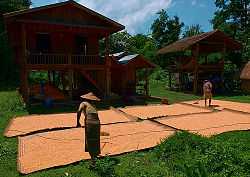Hsipaw
| Hsipaw သီပေါမြို့ Thibaw | |
|---|---|
 | |
 Hsipaw | |
| Coordinates: 22°37′N 97°17′E / 22.617°N 97.283°ECoordinates: 22°37′N 97°17′E / 22.617°N 97.283°E | |
| Country | Burma |
| Division | Shan State |
| Population (2005) | |
| • Religions | Buddhism |
| Time zone | MST (UTC+6.30) |
Hsipaw (Burmese: သီပေါ; Shan: သီႇပေႃႉ; also known as Thibaw), is a town in Shan State, Myanmar on the riverbank of Duthawadi River. It is 200 km (124 mi) northeast of Mandalay.
Shan Saopha
Hsipaw is perhaps one of the most well known and powerful saopha states of Shan State. According to the biography of Sao Hearn Hkam (the chief wife, Madhidevi of Sao Shwe Thaik, the first president of Myanmar and another saopha of Hsenwi), Hsipaw, along with Kengtung and Yawnghwe were the wealthiest and most powerful saopha states in Shan State.
The Saophas played fluctuating roles in regional Shan and national Burmese politics from the 11th century all the way till the 1962 military coup by General Ne Win.
Hsipaw is famous for the Bowgoy Pagoda, situated in Bowgoy Village about 6 miles far from Hsipaw.
You can take a trip to the beautiful palong(taann) nations mountain where you can see the most amazing mountain view. And the sunset of Hsipaw is famous and you can see the beautiful sunset and the overview of the town from sunset hill. You can enjoy the traditional foods such as shan noodle, rice soup, khawpok (traditional shan food makes with rice), pork rice (make to sour rice with pork) and you can drink dry tea and you can enjoy tea salad. Many seasonal natural fresh fruits such as orange, pine apple, water melon, passion, lychee, dragon fruit can be enjoyed.
Princes of Hsipaw
- Sao Hswe Kya (1788–1809)
- Sao Hkun Hkwi (1809–1843)
- Sao Hkun Paw (1843–1853)
- Sao Kya Htun (1853–1866)
- Sao Kya Hkeng (1866–1881)
- aucun (1881–1886)
- Sao Hkun Saing (1886–1902)
- (Sir) Sao Khe (1902–1928)
- Sao On Kya (1928–1959)
- Sao Kya Seng (1959–1962)
External links
 Scott, James George (1911). "Thibaw". In Chisholm, Hugh. Encyclopædia Britannica 26 (11th ed.). Cambridge University Press. pp. 846–847
Scott, James George (1911). "Thibaw". In Chisholm, Hugh. Encyclopædia Britannica 26 (11th ed.). Cambridge University Press. pp. 846–847- Viaja por libre. Hiking in Hsipaw
Gallery
-

Local houses
-

Locals building a bridge
-

The village primary school
-

View of Hsipaw

